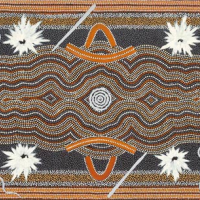49. CLIFFORD POSSUM TJAPALTJARRI Tjungurrayi and Tjapaltjarri Dreaming 1998

Clifford Possum Tjapaltjarri was born on Napperby Station about two hundred kilometres north-west of Mparntwe (Alice Springs). Like many other Anmatyerr people, his family moved to the east region of their country following the Coniston Massacre of the mid-1920s. The artist started his working life at diverse stations across Central Australia, where he acquired his impressive linguistic repertoire of six Western Desert languages, including his native Anmatyerr, and a little bit English. He refined his skill as a woodcarver while continuing to work as a stockman.
Tjapaltjarri joined Papunya Tula Artists in February 1972 and was one of their founding directors. He rapidly distinguished himself as one of the companys most accomplished and inventive artists, an exponent of striking, multi-layered and meticulously rendered visual effects. The artists unique artistic style developed rapidly and was characterised by its innovative use of spatial configuration beyond the more conventional Papunya idiom of dots, circles and lines. This inventiveness with space resulted in early paintings that conveyed a remarkable sense of atmosphere. These stood out from those of other Western and Central Desert artists, who were less preoccupied with evoking a psychological mood in their paintings. As he developed his art practice, Tjapaltjarri introduced Western iconography and figurative imagery to convey certain elements in his narratives. This played a dual role in both making them more intelligible to western audiences, and allowing him to create imaginative compositions within the Dreaming stories.
This masterful painting is associated with the secret/sacred Malierra (initiation) Ceremony that takes place at the mens business camp at Larunba (Napperby). In this ceremony, Tjungurrayi and Tjapaltjarri youths are led through ritual song, dance, ground designs, body art and secret/sacred practices designed to take them through the rites of passage to manhood. The tribesmen and youths are represented in this work as symbolic U-shapes accompanied by hair-string headbands and nulla nullas (fighting sticks).
The arc motifs resting in front of the men, lend form to the mens ceremonial body paint designs, as do the straight parallel bands shown along the picture plane. The dotted patterning along the centre of this painting represents ritual body art associated with Napperby Lake, which flows beneath the earths surface at Larumba where the men are in ceremony.
The star-like motifs represent native Spinifex grass, from which the men make resin that is used as a binder in spear and stone-knife making. Ash from spinifex is also used in Malierra. The mens sacred ground design is depicted in this work as three concentric circles which the artist, imitating the haptic nature of ground painting, created to appear as if painted by hand or, in the artists own words, finger, rather than a brush.